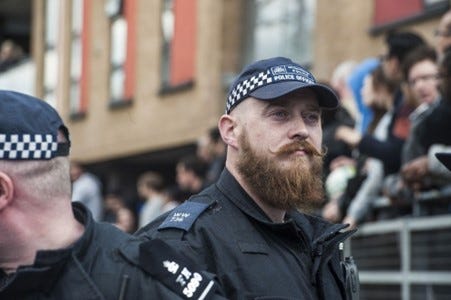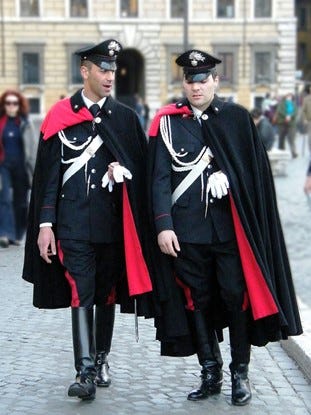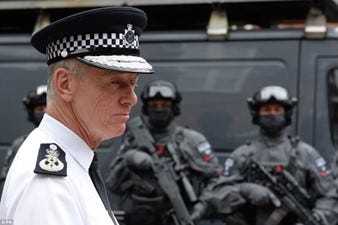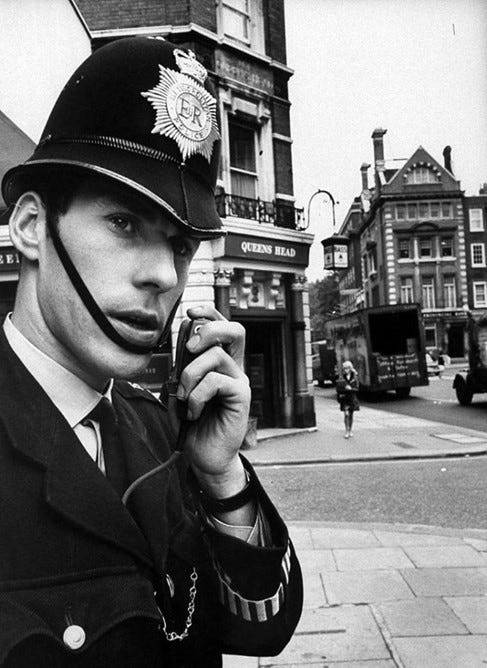Sort your hair out, Sarge. It’s a bloody mess
Today, a few thoughts on the significance of police uniforms. The flurry of media coverage around the TV series Happy Valley got me thinking about the subject (no, I haven’t seen it), because the dishevelled protagonist’s appearance drives me nuts. My favourite female ex-inspector would tell Sergeant Cawood to sort her barnet out, sharpish. Cress was guilty of this too, looking like she’d been let loose in a dressing-up box whenever she wore her uniform. On the other end of the scale, policing also attracts peacocks like Hogan-Howe (more of which later).
Okay, I’m on thin ice where this subject’s concerned; I last wore blue many, many moons ago. I’d spent six months on crime squads before I did my last patrol wearing a big hat. My itchy uniform trousers were, er, snug around the waist from office lunches and trips to the boozer. I remember being called up to patrol the pubs on the high street for Euro ‘96. It was a sunny afternoon shift, my last before I joined Special Branch (I remember buying a suit from a shop called ‘Blazer’ for the occasion, remember them?). Afterwards, I put my issued gear in a bin liner and handed it back to the divisional storeman. I never wore uniform again. All I have left are my epaulettes, a wooden truncheon and, for some reason, a bloody horrible yellow Hi-Viz jacket. If the Met wants ‘em back, ping me an email.
I think you can tell a lot about a police service (I’d prefer it to be a force but we are where we are) from its appearance. Uniforms have a special cultural and political significance. When I wrote this not-very-serious article on the subject of military fashion a few years ago, it quickly went viral.
Therefore, I think the parlous state of UK policing’s partly reflected by the average copper’s appearance – I stand by my description of modern response teams resembling paramilitary binmen and women. Long shifts, poor diet, flagging morale and stress leads to many looking unfit and unkempt. This is possibly compounded by the Millennial and Generation ‘Z’ fashion for dodgy beards and tattoos. For the fifty-something me, I find it jarring. For younger generations? Probably not so much. Gender neutrality also means forces are under pressure to provide uniforms ignoring physiological differences between men and women, although maybe this isn’t an entirely bad thing. Females have always got the crappy end of the uniform stick.
Although I do think beards can look splendid on coppers. We just need a rule like the Navy – you’ve got two weeks to grow a full set. If you can’t? Shave it off. Behold this young lion;
‘Hipster Cop’ became famous a few years ago. I think he looks magnificent, especially the ‘tache. It makes him approachable, even in public order gear. It suggests a man of taste, but also good humour
There’s a certain sort of person who, for some unquantifiable reason, never looks quite right in uniform. I’m one of them (despite being a scout, air cadet and army reservist before I was a copper). Even as a plain-clothes policeman, I was never the smartest person in the room. Although, to be fair, some of that was role-specific. I’m also not troubled by my appearance, as anyone who knows me will tell you. For me, “you don’t look anything like a policeman” was more or less a compliment.
No, I’m not a uniforms sort of person.
Although, in my experience, most coppers who spend their career in uniform hate wearing it too. It’s almost impossible to look smart in budget workwear, Frankenstein boots and a hazmat-yellow stab vest that looks like something from the aisle of chaos at Lidl. Except that’s what the public and media expect; guardsman smart, Dixon of Dock Green ‘bobbies’ in Victorian helmets, simultaneously capable of safely disarming a nutcase armed with a machete without putting a hair out of place. This, I would suggest, illustrates one of the many dichotomies plaguing policing – the public’s demand for approachability versus its distaste for the reality of confrontation and violence. We want our cake and eat it, but a violent society is going to result in police officers festooned in protective equipment and accountability IT, right?
Why do you think Dixon of Dock Green got away with swanning about in a tunic, tie and no body armour for thirty-odd years (before Dirk Bogarde shot him)? Because, of course, there was no CCTV. If you spat at Pc Dixon between 1829 and 1995 he’d have punched your lights out and nobody could prove otherwise – or even care. QED, don’t diss Pc Dixon. Play silly games and win silly prizes.
Why else do you think the Italian Carabinieri gets away with cutting about like this? Because people don’t mess around with them in the first place. Was a famous Italian, Machiavelli, right when he observed it’s better to be feared than loved? Well, actually he suggested it’s best to be feared and loved, but if you can’t be loved…
Yes, the Carabinieri are poseurs but you wouldn’t want to gob off at one either. Countries with Gendarmeries expect a level of robustness from their coppers that the British do not
When I joined the Police, uniforms were uncomfortable and not especially smart. In the early 90s the Met had begun issuing NATO jumpers – the famous ‘woolly-pully’ – in lieu of tunics for everyday wear. This led to older officers calling probationers ‘Jumpers’. We did get issued tunics for court appearances and ceremonial occasions, along with formal overcoats (I wore mine only once, for Remembrance Sunday). We also received sweat-generating polycotton shirts, both long and short sleeved, itchy woollen trousers, a leather belt, two clip-on ties, a helmet, a peaked cap, a Gore-Tex anorak, a Hi-Viz jacket, a police box key (although there were no police boxes left) and a whistle. Female officers received comedy ‘A-line’ skirts and horrible trousers with little decorative buttons in lieu of proper pockets. Every female copper I’ve met despised police trousers. Although, as one told me, “they’re strangely egalitarian – they make everyone look like they’ve got a huge arse.”
We weren’t issued boots in those days, apart from female officers who were mysteriously given Wellingtons (I still don’t know why). The ladies also received a tacky leatherette handbag. Yes, I was jealous too. We were apparently paid ‘boot allowance’ to buy our own footwear (I never saw it on my payslip). I still had my old army boots and wore those to save money. We also received dry cleaning vouchers. Can you imagine that now? They went out with luncheon vouchers, VHS video recorders and the Ark.
The rarest item of clothing, for some bizarre reason, were the removable cloth epaulettes worn on your outermost piece of uniform. Why they were so scarce is a mystery, but they became a sort of currency at my station. You’d often hear the following conversation;
Pc Smith: “I’m retiring / transferring to CID / resigning / been told I’ve got six months to live.”
Pc Jones: “Can I have your epaulettes?”
Epaulettes – possibly fashioned from panda skin or unicorn pelts, they were a precious commodity
Other things I remember about police uniforms?
The shop at Hendon selling a little leather pen-holder for your belt. That was the only tactical accessory available in 1992
The steel rose on top of your custodian helmet being bashed in by older officers as soon as you arrived at your first nick, a bit like kids at school stamping on a new pair of shoes
Ditto the cock-and-balls scrawled in felt-tip pen inside your peaked cap
The macho coppers who wore short-sleeved shirts with no tie all-year round. Usually seen in a police car with the window open, along with a female officer wearing two jumpers, an anorak, thermal gloves and a scarf
The truncheon pocket in your trousers where you’d hide your little wooden stick. Can’t have the public see Old Bill with weapons!
And of course the infamous clothing van, the mobile quartermaster who’d rock up at a police station carpark and leave a sign outside saying he was free to issue kit between 11.00 and 11.05
I’m sure my older and bolder readers will remember this stuff, in the days before fleeces, Tasers, body-cameras, combat trousers, stab vests and rainbow epaulettes.
Yes, 90s uniforms were pretty crappy. They were still smarter than today’s.
If there’s a theme in my writing, it’s the structural dichotomies that dog the Police. In the case of uniform, as I mentioned before, the primary issue is approachability versus protection. The latter is compounded by some coppers who love dressing up like commandos. They tend to congregate in what I would call ‘kinetic’ roles like firearms and public order. You only have to check this article from 2016, where the capo dei capi of kit-lovers, Bernard Hogan-Howe, can barely contain his excitement as he introduces his sexy new firearms ninjas. I was in the Job at the time and even people I knew in firearms were chuckling at the macho ‘show of force’. Look, Arc’teryx wolf-grey uniforms at a grand a pop! Operators on motorbikes! Gunmen wearing balaclavas! Weapons with sexy lasers bolted on the barrels!
Bernie approves. Oh yes, he really does
Lord Hogan-Howe clearly relished ceremonial and, especially, horses. His dressing-up tendency went in a very non-tactical direction; he seemed to love badges, medals, trousers with silver stripes and silly hats. What was even funnier was watching other seniors trying to get in on the act in order to impress the Boss. They know who they are. The Mounted Branch riding school at Imber Court apparently had a waiting list of guvnors who mysteriously developed an interest in matters equestrian.
Nothing better illustrated the World War One vibe of the Met Police - the poor bloody infantry at the front wearing crappy gear while the generals ponced around on horses.
Please don’t think I’m looking to alienate SCO19 officers, who I respect a great deal (unlike senior officers on horses, about whom I give no fucks whatsoever). I know many ninjas who are as tired of the Tacticool poseurs as the rest of us. This doesn’t change the uncomfortable fact there’s an unhealthy level of gun fetishism, which percolates into the wider service.
I once took a tube journey with a good friend who happens to be a former SFO (specialist firearms officer), rifle instructor and door-kicker. Two British Transport Police officers clambered into our carriage wearing full tactical Robocop rig, equipped with rifles, pistols, balaclavas (seriously), helmets and (for all I knew) antitank rockets. “That’s a bit much, isn’t it?” I asked my mate, as I have a rudimentary understanding of ballistics when it comes to the efficacy of using 5.56 rounds on public transport. I even passed a police firearms course.
“I reckon so,” my mate shrugged. “I’d wear blue coveralls, a beret and carry an MP5 (he loves the MP5 like 80s squaddies love the SLR), but I’m old-school.”
I know we live in an era of terrorism and active shooters. I get it. I’m also firmly of the view coppers who dress like soldiers tend to behave like soldiers (hint - join the army, guys). And although there’s a tiny slice of overlap in the Venn diagram between policing and soldiering, it’s just that; tiny.
Ah, I hear you say (not unreasonably), coppers who do dangerous work deserve proper protective equipment. Yes, you’re absolutely one hundred percent correct. In which case, answer me this; why do those performing quantifiably the most dangerous police roles in terms of death and injury – community and response officers – receive the lamest kit? That’s largely down to politics and resources; those sexy Home Office counterterrorism budgets get spent on smaller numbers of specialists, not the hoi polloi doing bread and butter policing. Me? I’d devolve certain specialisms to local control, but that’s another subject for another day. And the gods help anyone brave enough to try and break the the Met’s specialist empires.
This imbalance was ever thus. Until we reverse it (especially in the Met) by empowering, recognising and – yes – smartening up our patrol and response officers, we won’t begin to see the changes we need. These officers deserve the best kit. Train them thoroughly. Give them smart uniforms. Lead them properly. Give them an esprit de corps. Watch the difference.
In his own way, this Pc owned the streets more effectively than any number of body-armoured coppers carrying Tasers or even guns. Not nostalgia - just a fact. The problem is, do we want his methods?
I remember going on foot patrol with an old sweat coming up to retirement. He’d worked our division for twenty-odd years. He was a properly hard man. Not very nice, to be honest, although he scared the shit out of the locals who needed to be scared. He could smell a wrong ‘un on the wind like a wolf. The old sweat looked mustard, though. Polished Chelsea boots, starched creases in his shirt sleeves. He wore his dad’s old-fashioned cork beat duty helmet with a Kings Crown, the leather truncheon strap looped neatly around his belt so people could see it. He’d walk slowly along the street, shoulders squared, muttering under his breath about how fucked the world was. When he saw a particularly annoying or incalcitrant member of the public, or after another testy stop and search, he’d say, “the Public get the Police they deserve. If we’re cunts, it’s because they are too.”
I think at Hendon they would have called this a ‘negative feedback loop,’ but not in 1964 when this guy marched off the square.
What I’m saying is a culture that doesn’t know what it is or what it wants, a messy and shabby culture, will get a messy and shabby police force. We can’t agree who needs to be scared of the police, or even if they should. Formality and tradition - yes, even smartness - are seen in those dreaming spires, where our decision-makers are educated, as reactionary. Exclusionary. Part of our sordid imperial past.
How do we even begin putting that right? I don’t know, but a society with shared values, one that doesn’t see coppers as YouTube troll-bait, might be start. Until then, we’ll get the police we deserve. It is a feedback loop. Demoralised people - police included - tend to suffer from diminished self-respect. Their appearance is often the first thing to go. But you can’t just tell someone to smarten themselves up. They need a reason why. Self-respect doesn’t come in bottles. It comes with experience, training, leadership, mentoring and culture. Not with a workforce dressed in cheap nylon workwear made in sweatshops. Not with officers selected and trained via Zoom interviews. Not led by clueless kids or direct entry civil servants. Not with supervisors unprepared to call out sex pests and wrong ‘uns.
The ideal police officer of the future won’t resemble Dixon of Dock Green either – why should we look backwards? On the other hand, hopefully, nor will they look like Robocop. Ideally they’ll reflect a society that desires to be policed competently and compassionately. That appearance should be evolutionary and mission-appropriate. What would that look like? I’d really like to know.
All I do know is it’s largely - and quite properly - out of the hands of the police.










Prior to joining the police I spent 3 years growing up in the Army. I got much more from the military than they got from me. Smartness, order and a disciplined organisation worked wonders on an immature juvenile that was me. I also loved the SLR but let’s not get sidetracked!
When I joined the police service the change was far less traumatic than it was for my civilian colleagues. An ability to wear a uniform and look after it helped avoid the attention of training and section sergeants. It also made for a professional approach to policing. Most of our ‘customers’ appreciated and respected the police, an imposing uniform helped this. Those that didn’t soon learnt why the Police Force was so called.
The slow transition from smart uniform and helmet, a wooden truncheon together with a PNB and a HORT 1 pad to utility belts (awful!), vests, blacks, extendable batton, taser etc were all justified by the changes in society and the need to protect our officers. However, the uniform changes coupled with the decline in patrols on the streets have helped isolate the police from their customers, the public…. It will take a concerted effort to improve confidence in the police, being accessible and identifiable as police officer’s will help. An increase in police numbers, better terms of service and a separation between politics and the police (goodbye PCC’s) can’t come soon enough.
Yep, I had the 'tit' on my helmet flattened within days of moving from Street Duties onto A Relief at Acton in '86. Stopped it falling over when I put it down though! Some of us bought nylon webbing 'utility belts' to house some of the kit we were issued. Bosses said we shouldn't as apparently they melted at 200 degrees Celsius and were therefore dangerous. If we're exposed to temps in excess of 200 degrees who gives a flying f**k about our kit melting?!?!